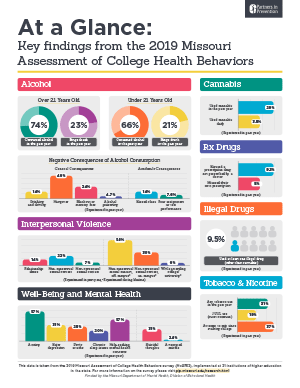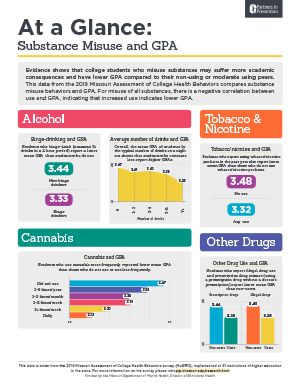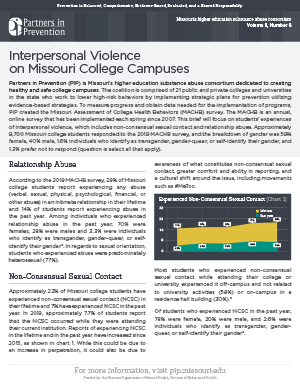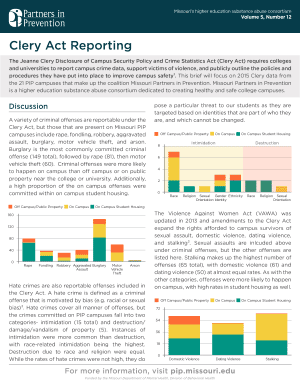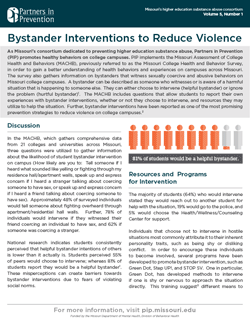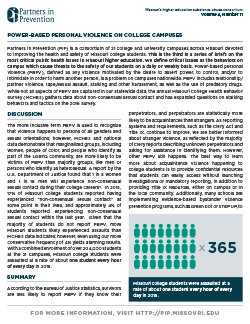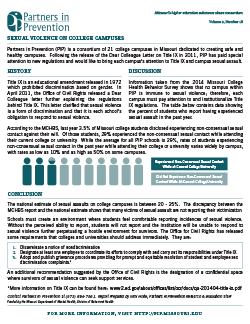
Interpersonal Violence

1 in 5 women and 1 in 16 men are sexually assaulted while in college.
The majority of these crimes are never reported. Power-based personal violence is a serious public health issue affecting college students nationwide. Addressing power-based personal violence requires campus-wide recognition of the serious impact these acts of violence have. Compiled here are resources to help address power-based personal violence with trauma-informed prevention, responses, and support services.
Scope
National Data
11.2% of all students nationwide experience rape or sexual assault through physical force, violence, or incapacitation (among all graduate and undergraduate students)
Among graduate and professional students, 8.8% of females and 2.2% of males experience rape or sexual assault through physical force, violence, or incapacitation
Among undergraduate students, 23.1% of females and 5.4% of males experience rape or sexual assaultthrough physical force, violence, or incapacitation
Among college women,9 out of 10victims of sexual assault knew the person who sexually assaulted them
27% of college women have experienced some form of unwanted sexual contact
4.2% of students have experienced stalking since entering college
Nearly two-thirds of college students experience sexual harassment, and less than 10% of these students tell a college or university employee
Missouri Data
22% of Missouri college students report experiencing non-consensual sexual contact in their lifetime and 7% report experiencing non-consensual sexual contact in the past year
35% of Missouri college students indicate that the non-consensual sexual contact occurred while attending their current college or university
When asked where the non-consensual sexual contact occurred, respondents reported:
| 58% | 39% | 12% | 4% | 1% | 2% |
| Off-campus | On-campus (non-university) | During break | Off-campus (univeristy-related) | Study abroad | PNR |
8% of students report being stalked in the past year and 1% perferred not to respond
In the past year, 14% of Missouri college students report experiencing abuse in a relationship. Missouri college students report experiencing the following abusive behaviors in intimate relationships*:
| 23% | 20% | 9% | 8% | 6% |
| Psychologically abusive | Verbally abusive | Sexually abusive | Physically abusive | Financially abusive |
Population Considerations
21% of TGQN (transgender, genderqueer, nonconforming) college students have been sexually assaulted, compared to 18% of non-TGQN females, and 4% of non-TGQN males
Individuals who identify as bisexual experience higher rates of sexual violence than their heterosexual or gay/lesbian peers (74.9% of bisexual women and 47.4% of bisexual men compared to 43.3% and 20.8% of heterosexual women and men, respectively, and 46.4% of lesbians, and 40.2% of gay men)
Other Considerations
More than 50% of college sexual assaults occur in either August, September, October, or November
Students are at an increased risk during the first few months of their first and second semesters in college
Only 20% of female student victims, age 18-24, report to law enforcement
81% of women and 35% of men report significant short-term or long-term impacts such as Post Traumatic Stress Disorder
Data Briefs
Click on a brief below for more information.
At a Glance
Volume 8
Volume 6
Volume 5
Volume 4
Volume 3
Volume 2
Best Practices
The CDC has comprehensive guides on Sexual Violence on Campus: Strategies for Prevention and their newest resource is Stop SV: A Technical Package to Prevent Sexual Violence
Culture of Respect has a good rubric outlining various online, performance-based, and mixed method sexual assault prevention programs
The NCAA released a document on Sexual Violence Prevention: An Athletics Tool Kit for a Healthy and Safe Culture
Bystander Intervention Programs
- The National Sexual Violence Resource Center has a great publication on engaging bystanders in sexual violence prevention
- The Green Dot program is a nationally recognized bystander intervention program to address dating and relationship violence, sexual assault, and stalking
- Step Up is another nationally recognized bystander intervention program
- Bringing in the Bystander In-Person Prevention Training is another recognized bystander intervention program
Healthy Relationship Programs
- Safe Dates is a dating abuse-prevention program geared towards middle and high school students, but could be adapted for college age individuals
Healthy Sexuality
- The NSVRC has a guide on healthy sexuality for advocates, counselors, and prevention educators
Men’s Work in Prevention
- Coaching Boys into Men is an evidence based program to engage boys, specifically athletes, in preventing domestiv violence, sexual assault, and teen dating abuse
National Resources
- National Sexual Violence Resource Center: nsvrc.org
- Missouri Coalition Against Domestic and Sexual Violence: mocadsv.org
- RAINN: rainn.org
- National Alliance to End Sexual Violence: endsexualviolence.org
- National Center on Domestic and Sexual Violence: ncdsv.org
- Resource Sharing Project: resourcesharingproject.org
- Centers for Disease Control – Sexual Violence Prevention: cdc.gov/violenceprevention/sexualviolence
- Green Dot: alteristic.org/services/green-dot
PIP Resources
- Messaging About Intersection of Alcohol and Violence
- CDC Stop SV Technical Package
- 2017 Report: Missouri Campus Efforts to Address the Intersection of Alcohol and Sexual Violence
Title IX/Clery Resources
Please click the title of each resource to read a description and learn more details.
Campus Climate Survey resources
University of Missouri Campus Climate Survey Presentation
University of Missouri Campus Climate Report
National Sexual Misconduct Campus Climate Survey
Articles Tying Alcohol Prevention to Sexual Violence Prevention
Department of Justice Special Report: Campus Law Enforcement, 2011-12
Sexual Violence and Alcohol PoliciesThe Role of Alcohol Policies in Preventing Intimate Partner Violence: A Review of the Literature
Title IX, Clery Act, Campus SaVE Act and VAWA Explained
- Dear Colleague Letter, July 2015- providing a summary of the final VAWA regulations implementing statutory changes to the Clery Act
- Final Regulations Document, 2015 from the US Department of Education
- Click here to download
- Title IX Evolution and Sexual Harassment (Robert Clay)
- Clery Act History (Robert Clay)
Action Items for Your Campus to Consider
The Obama Administration today announced publication of the final rule implementing changes made to the Jeanne Clery Disclosure of Campus Security Policy and Campus Crime Statistics Act (Clery Act) by the Violence Against Women Reauthorization Act of 2013 (VAWA). That law and the new rule strengthen the Clery Act to more effectively address, and ultimately reduce, sexual violence on college campuses, including, domestic violence, dating violence, and stalking.Although the final rule will not go into effect on July 1, 2015, the Department reminded institutions that the VAWA statutory provisions are in effect now and institutions are expected to make a good faith effort to comply with those requirements.
Senator Claire McCaskill’s Campus Sexual Assault Survey results
- Senator Claire McCaskill (D-Mo.) released the anticipated results of her campus sexual assault survey in a report titled, “Sexual Violence on Campus: How Too Many Institutions of Higher Education are Failing to Protect Students.” http://www.mccaskill.senate.gov/SurveyReportwithAppendix.pdf
After surveying a national sample of 440 four-year institutions of higher education, Sen. McCaskill has detailed a number of shortcomings she believes “affect nearly every stage of the institutions’ responses to sexual violence” and demonstrate that “many institutions are failing to comply with the law and best practices in how they handle sexual violence among students.”
The following points are highlighted in the report’s executive summary as key findings from the survey:Important note: The appendix of the report includes a detailed breakdown of every survey question, which includes how the respondents answered according to institutional type (large, small, public, private, NCAA division, etc.).
- Lack of Knowledge About the Scope of the Problem.
- Failure to Encourage Reporting of Sexual Violence.
- Lack of Adequate Sexual Assault Training.
- Reported Sexual Violence Goes Uninvestigated.
- Lack of Adequate Services for Survivors.
- Lack of Trained, Coordinated Law Enforcement.
- Adjudication Fails to Comply with Requirements and Best Practices.
- Lack of Coordinated Oversight.
NASPA looks at what Senator McCaskill’s report contains and what it means for your campus Climate Surveys: Useful Tools to Help Colleges and Universities in Their Efforts to Reduce and Prevent Sexual Assault Technical Assistance Guide and Resource Kit for Primary Prevention and Evaluation Beyond Title IX: Guidelines for Preventing and Responding to Gender-based Violence in Higher Education Q&A on Title IX and Sexual Violence from the United States Department of Education and the Office for Civil Rights White House Task Force to Protect Students from Sexual Assault Report (April 2014)
Examples from Other Campuses
MU Title IX Office Annual Report
University of Missouri’s Equity Office Title IX Website University of Missouri’s Relationship and Sexual Violence Prevention Center Northwest Missouri State University Title IX Website University of Central Missouri’s Title IX Website Lincoln UniversityClery Page Title IX Info Page Sexual Assault Domestic Violence Dating Violence & Stalking Policy *Contact Robert Clay at (573) 681-5497 or clayr2@lincolnu.edu for more information.
News Articles, Peer-Reviewed Literature and Other Important Information
Helping to Protect Students from Sexual Assault
The Center for Changing Our Campus Culture- The U.S. Department of Justice’s Office on Violence Against Women (OVW) announced the launch of The Center for Changing Our Campus Culture (www.changingourcampus.org), a new comprehensive online clearinghouse on sexual assault, domestic violence, dating violence, and stalking on campus. This new website provides the latest information, materials and resources for campus administrators, faculty and staff, as well as campus and community law enforcement, victim service providers, students, parents and other key stakeholders to use to improve campus safety.
- In August 2014, a summit was held to bring together campus officials from around the U.S. to discuss unresolved issues around Title IX and other related legislation, including the Clery Act and the Violence Against Women Act. During the summit, campus police, administrators, deans of students, Title IX and Clery Act staff, and others met to work toward better compliance. Following the summit, a list of issues and promising practices was created. To access this resource, click here.
note: many of the research articles included in this roundup can be found above. Bystander Intervention Videos by Alan David Berkowitz Shining a Spotlight on the Arizona Safer Bars Alliance: Working to Reduce and Prevent Sexual Assault Missouri State University Students to Receive Training on New Title IX Policy Colleges Are Reporting More Sexual Assaults, And That's A Great Sign A Scripted Response to Sexual Assault
Research
Relevant Research Articles
- A systematic review of primary prevention strategies for sexual violence perpetration
- Preventing Sexual Violence on College Campuses: Lessons from Research and Practice
- Improving College Campus-Based Prevention of Violence Against Women
- Mobilising Men in Practice: Challenging Sexual and Gender-based Violence in Institutional Settings
- A Critical Review of Sexual Violence Prevention on College Campuses
